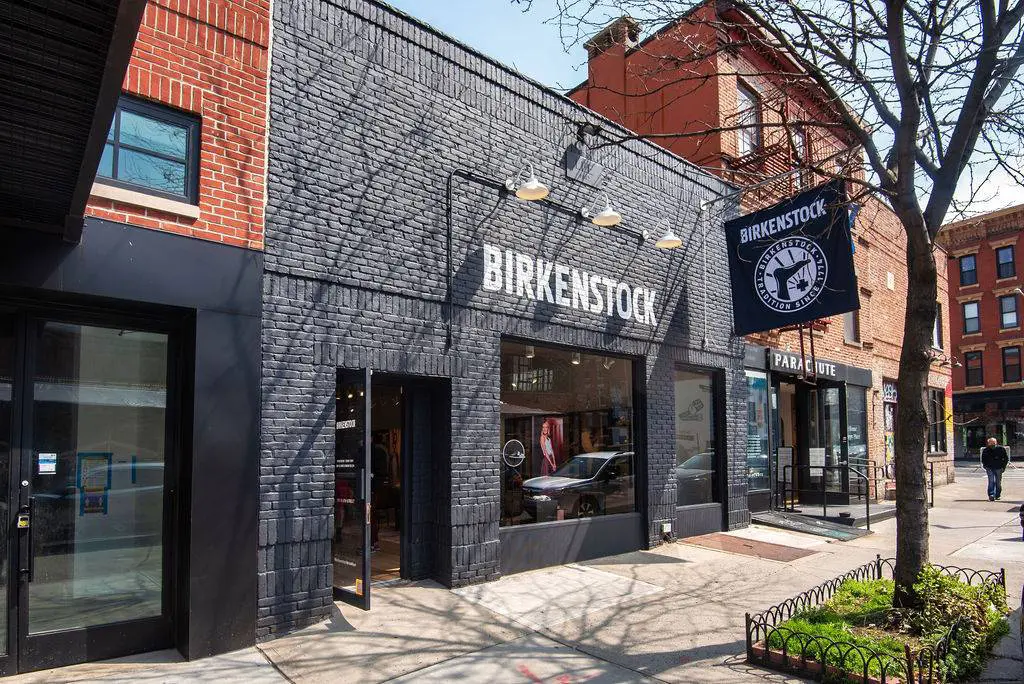

Birkenstock is ready for the revival of physical retail.
After experiencing one of its strongest years ever in 2020 — thanks to a global consumer shift toward comfortable (and comforting) work-from-home fashion — the Germany-based footwear brand is expanding its presence in the U.S., by debuting a flagship store in Brooklyn, N.Y.’s hipster haven of Williamsburg.
The opening marks only the third stateside retail location for the company, which now counts 54 owned stores globally.
Prior to the pandemic, Birkenstock had been taking a slow-and-steady approach to owned retail in the U.S. Its first stateside flagship debuted in New York’s SoHo neighborhood in 2018, followed by a location in Venice Beach, Calif., in 2019.
David Kahan, CEO of Birkenstock Americas, told FN that Birkenstock is positioning itself to take advantage of the coming consumer resurgence. “We believe post-COVID there will be a significant return to in-person retail shopping and consumer engagement,” he said. “Since our consumers are more brand ‘fans,’ what can be better than having physical outposts where they can connect with us.”
The Williamsburg shop is located at 111 N. 6th St., on a block that also houses stores for Madewell, Everlane and Urban Outfitters. The space was designed to reflect the brand’s history and signature elements, by incorporating materials such as cork, leather and white oak. It also features a large, vibrantly colored mural, titled “Flowing Toes,” that was created by Brooklyn-based artist Mike Perry and takes inspiration from city life.
It will stock the brand’s full footwear collection, including styles for men, women and kids, as well as special limited-edition collaborations and the Birkenstock Natural Skin Care line.
For the past several years, Williamsburg has emerged as a major hotspot for retail, and Joseph Aquino, president of New York-based real estate firm JAACRES, said that trend has only accelerated during the pandemic, as many residents in the outer boroughs have stopped commuting into Manhattan. “The mass [retail brands] are now in the residential neighborhoods,” he explained. “In fact, the luxury brands are looking for outposts in neighborhoods now for the same reason.”
While retail lease rates in Manhattan have dipped slightly during the past year, Aquino noted that rents in the boroughs have held steady, “especially in neighborhoods like Williamsburg.”
Kahan agreed that there is a retail shift happening, away from traditional hotspots like 5th Avenue toward neighborhoods where people live and work. While Soho has been a challenge for some retailers, “our shop [there] is exceeding all expectations and gives us a proof point,” Kahan said. “The same in Venice Beach versus, let’s say, the Santa Monica Third Street Promenade. We see Williamsburg as another great example of being where our fans live, work and play.”
Another sea-change brought on by the COVID-19 pandemic has been the consumer migration toward e-commerce — a trend that some experts have suggested could become permanent now that shoppers have experienced the convenience of online and familiarized themselves with the process.
But instead of fighting against the headwinds of digital, Kahan said Birkenstock is embracing the opportunities by taking an omnichannel approach to its retail. “Our physical locations will all be 100% integrated with our digital business,” said the CEO. “There is no longer a defined line between our shops and our online store.”
At the same time, it will continue to foster traditional shoe-selling tactics. “Our stores are staffed by true brand missionaries — this isn’t old retail staff thinking. They are experts at fitting and serving the needs of all who enter the store and are also fully capable of facilitating digital transactions,” said Kahan.
Birkenstock is on quite a winning streak. Last year, Birkenstock Group co-CEO Oliver Reichert told FN that the company’s annual revenues for fiscal 2020 (which ended last September) had easily surpassed the prior year. The strength of the comfort shoe brand was so great, in fact, that it began courting multiple investors, eventually landing a deal with private equity firm L Catterton and Financière Agache. The two investment vehicles — backed by LVMH Moët Hennessy Louis Vuitton and luxury titan Bernard Arnault and his family respectively — acquired a majority stake in Birkenstock and are helping to fuel its global expansion, particularly in Asia.
As for its growth prospects here in the States, Kahan said the brand is “actively seeking” more retail locations, but it will continue to wait for the right spaces under that right terms. “We are very patient and very deliberate,” he said. “Remember, it took us two years in SoHo to find the exact location we wanted.”
Birkenstock Opens Its Third US Flagship — Why the Brand Still Believes in Brick & Mortar Retail


